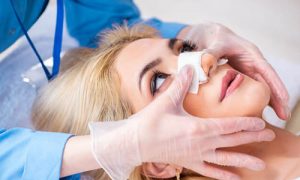A rhinoplasty procedure is a popular treatment for correcting and reconstructing the nose. This cosmetic enhancement is commonly known as nose job or nose . Unfortunately, some patients have unsuccessful outcomes, resulting in a nose job gone wrong. Keep reading to learn more about the different complications related to an unsuccessful nose job and the treatment to address the issue.
When Nose Jobs Go Wrong
Like other cosmetic medical procedures, rhinoplasty or nose job can go wrong, especially if it is done by an unqualified doctor. Common issues include
External Issues
External issues are one of the common problems after nose . In fact, patients with external issues need to wait a year for their nose to totally recover before considering further .  Nevertheless, there are more severe cases that require other surgical procedures to address the concern.
Nevertheless, there are more severe cases that require other surgical procedures to address the concern.
Tip of the Nose
The tip of the nose can be vulnerable to some issues, mainly the loss of too much cartilage. This complication can distort or even break down the nostrils.
Over-extension on the nose tip can likewise cause it to appear excessively prominent. In any case, reconstructive may help replace the lost cartilage to restore a more natural appearance on the nose.
Twisted Nose
This issue happens when a doctor accidentally twists the nasal bones on the top and tip of the nose. Fixing a damaged nose like this might be difficult to accomplish during rhinoplasty. However, strengthening the cartilage with stitches may help achieve the desired outcome.
Internal Issues
Unfortunately, rhinoplasty may also affect the inner parts of the nose. This complication is rare compared to external issues. However, internal issues may leave permanent damage.
Breathing Problems
Breathing issues like nasal congestion usually appear after the procedure because of postoperative swelling that disperses within weeks or months. Long-term breathing problem is concerning, yet your doctor can evaluate and treat them accordingly. Possible issues such as the deviated septum, enlargement of the turbinate, scarring, or significant alterations can also contribute to breathing complications.
Nerve Damage and Numbness
These issues commonly settle within a few weeks to months. The sensory nerves on the nose and infrequently on the upper lip are temporarily cut off during the procedure. Additionally, at times, long-lasting or permanent numbness might happen.
Infection
Though rare, infection after rhinoplasty may happen. However, taking antibiotics may help treat an infection. In any case, some very uncommon conditions might require special medical attention from the doctor and an infectious disease professional.
Revision Rhinoplasty For a Nose Job Gone Wrong
Revision rhinoplasty can help correct complications from a previous nose job, whether it is functional or aesthetic. This treatment can be performed using either a closed or open technique.
Open rhinoplasty creates a cut across the nose base, while the closed method requires internal incisions. The technique will depend on the goals of the procedure and the doctor’s suggestion.
Furthermore, communicating any concerns about your rhinoplasty with your doctor is significant. Some temporary or minor cases may not require further treatment. Nevertheless, revision is ideal for correcting aesthetic or breathing issues.
How Soon Can I Undergo Rhinoplasty Revision?
A bad nose job can be a disappointing experience. In fact, several affected patients are headed to address the issue right away. Nevertheless, a doctor can only perform revision rhinoplasty at least one year after the initial .
It requires some amount of time for the body to recover and for the swelling to die down. Swelling might not be a big deal, yet it can distort the actual outcomes of rhinoplasty . It can cause the nose to appear bigger than it truly is, persuading the patient that their facial appearance is less attractive. Besides, waiting for a year will permit scar tissue to be mellow and make the revision method simpler to perform.
Selecting Your Rhinoplasty Surgeon
It is difficult to control how rhinoplasty will go once it starts. However, there are numerous ways to keep away from a displeasing nose job.
Choosing a qualified and trained cosmetic doctor is the first and most significant step. At Refine Clinic, our doctors strive to give patients with comprehensive information about a rhinoplasty procedure. This includes answering patients’ inquiries, explaining their ideal outcomes and even allowing them to see before and after photos to get a sense of the doctor’s technical and aesthetic abilities. If you want to talk to one of our highly trained doctors, visit our clinic or call us at (02) 8880 5116 today!
References
Nasal congestion.
https://www.mayoclinic.org/symptoms/nasal-congestion/basics/definition/sym-20050644
Open Rhinoplasty.
https://www.ncbi.nlm.nih.gov/books/NBK546628/
The Anatomy of the Nasal Bone.

